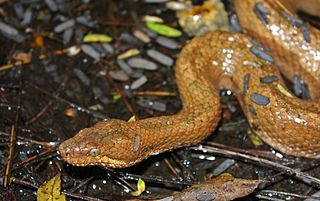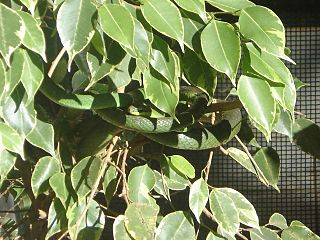
The Boidae, commonly known as boas or boids, are a family of nonvenomous snakes primarily found in the Americas, as well as Africa, Europe, Asia, and some Pacific islands. Boas include some of the world's largest snakes, with the green anaconda of South America being the heaviest and second-longest snake known; in general, adults are medium to large in size, with females usually larger than the males. Six subfamilies comprising 15 genera and 54 species are currently recognized.

Enyalioides is a genus of lizards in the family Hoplocercidae. The genus is native to the northern part of South America and Panama.

The green anaconda, also known as the giant anaconda, emerald anaconda, common anaconda, common water boa, or southern green anaconda is a boa species found in South America and the Caribbean island of Trinidad. It is the largest, heaviest and the second longest snake in the world. No subspecies are currently recognized. Like all boas, it is a non-venomous constrictor.

The Tropidophiidae, common name dwarf boas or thunder snakes, are a family of nonvenomous snakes found from Mexico and the West Indies south to southeastern Brazil. These are small to medium-sized fossorial snakes, some with beautiful and striking color patterns. Currently, two living genera, containing 34 species, are recognized. Two other genera were once considered to be tropidophiids but are now known to be more closely related to the boids, and are classified in the subfamily Ungaliophiinae. There are a relatively large number of fossil snakes that have been described as tropidophiids, but which of these are more closely related to Tropidophis and Trachyboa and which are more closely related to Ungaliophis and Exiliboa is unknown.

Chironius is a genus of New World colubrid snakes, commonly called sipos, savanes, or sometimes vine snakes. There are 23 described species in this genus.

Tropidophis melanurus, commonly known as the dusky dwarf boa, Cuban wood snake, or Cuban giant dwarf boa, is a nonvenomous dwarf boa species found mainly in Cuba. There are three subspecies that are recognized as being valid, including the nominate subspecies described here.
Tropidophis fuscus is a nonvenomous dwarf boa species endemic to Cuba. There are no subspecies that are recognized as being valid.
Tropidophis morenoi, also commonly known as the zebra dwarf boa and the zebra trope, is a species of snake in the family Tropidophiidae. The species is endemic to the West Indies.
Tropidophis greenwayi is a nonvenomous dwarf boa species endemic to the Caicos Islands. Two subspecies are currently recognized, including the nominate subspecies described here.
Pristimantis luscombei is a species of frog in the family Strabomantidae. It is known from north-eastern Peru, adjacent Amazonian Ecuador, and from Acre state, Brazil. Some of the paratypes were later identified as belonging to another species, described in 2014 as Pristimantis miktos. At the same time, Pristimantis achuar was identified as synonym of Pristimantis luscombei.

The Bolivian river dolphin is a species of the genus Inia.

The Bahamian pygmy boa constrictor, also known as the Inagua trope or Bahama wood snake, is a species of nonvenomous snake in the family Tropidophiidae. The species is endemic to Great Inagua Island in the Bahamas.
Tropidophis battersbyi, also known commonly as Battersby's dwarf boa and the Ecuadorian dwarf boa, is a species of snake in the family Tropidophiidae. The species is endemic to Ecuador.

Tropidophis feicki, also known commonly as the broad-banded dwarf boa, the broad-banded trope, and Feick's dwarf boa, is a species of non-venomous snake in the family Tropidophiidae. The species is endemic to Cuba.
Tropidophis nigriventis, or the black-bellied dwarf boa, is a species of snake in the family Tropidophiidae. The species is endemic to Cuba.
Tropidophis pilsbryi, commonly known as Pilsbry's dwarf boa or the Cuban white-necked dwarf boa, is a species of snake in the family Tropidophiidae. The species is endemic to Cuba.

Tropidophis taczanowskyi, also known commonly as Taczanowski's dwarf boa, is a species of snake in the family Tropidophiidae. The species is native to northern South America.
Tropidophis wrighti, commonly known as Wright's dwarf boa, the gracile banded dwarf boa, and the gracile banded trope, is a species of snake in the family Tropidophiidae. The species is endemic to Cuba.

Eunectes beniensis is a boa species known only from the northeastern parts of Bolivia. Its common names, the Bolivian anaconda and Beni anaconda, are derived from the geographic location of its native habitat: the Beni area of Bolivia. Like all boas, it is nonvenomous.

Noblella is a genus of frogs in the family Strabomantidae. They are found on the eastern slopes of the Andes and in the Amazon Basin in Colombia, Ecuador, Peru, Bolivia, and western Brazil. The name refers to Gladwyn K. Noble, who described the first species.












